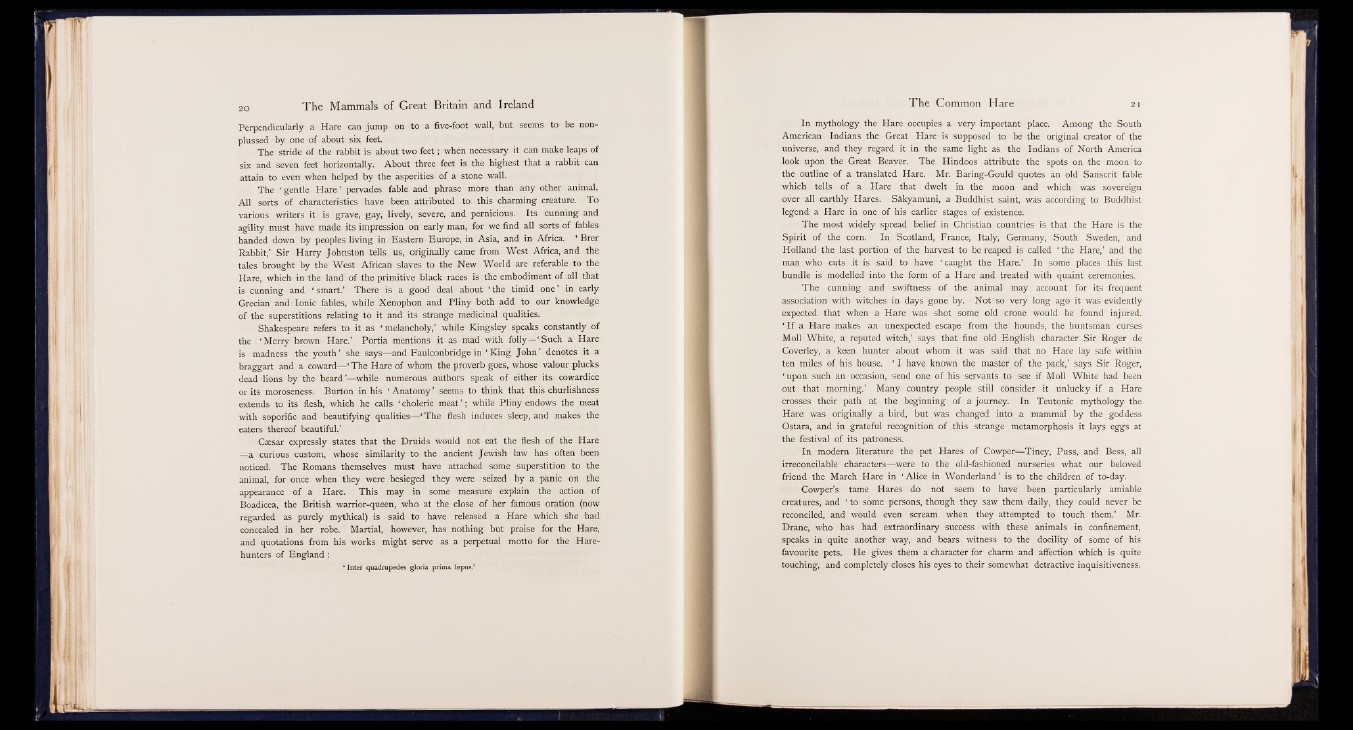
Perpendicularly a Hare can jump on to a five-foot wall, but seems to be nonplussed
by one of about six feet.
The stride of the rabbit is about two feet; when necessary it can make leaps of
six and seven feet horizontally. About three feet is the highest that a rabbit can
attain to even when helped by the asperities of a stone wall.
The ‘ gentle Hare ’ pervades fable and phrase more than any other animal
All sorts of characteristics have been attributed to this charming creature. To
various writers it is grave, gay, lively, severe, and pernicious. Its cunning and
agility must have made its impression on early man, for we find all sorts of fables
handed down by peoples living in Eastern Europe, in Asia, and in Africa. * Brer
Rabbit,’ Sir Harry Johnston tells us, originally came from West Africa, and the
tales brought by the West African slaves to the New World are referable to the
Hare, which in the land of the primitive black races is the embodiment of all that
is cunning and ‘ smart.’ There is a good deal about ‘ the timid one ’ in early
Grecian and Ionic fables, while Xenophon and Pliny both add to our knowledge
of the superstitions relating to it and its strange medicinal qualities.
Shakespeare refers to it as ‘ melancholy,’ while Kingsley speaks constantly of
the ‘ Merry brown Hare.’ Portia mentions it as mad with folly—‘ Such a Hare
is madness the youth ’ she says— and Faulconbridge in ‘ King John ’ denotes it a
braggart and a coward— ‘ The Hare of whom the proverb goes, whose valour plucks
dead lions by the beard'— while numerous authors speak of either its cowardice
or its moroseness. Burton in his ‘ Anatomy ’ seems to think that this churlishness
extends to its flesh, which he calls ‘ choleric meat ’ ; while Pliny endows the meat
with soporific and beautifying qualities— ‘ The flesh induces sleep, and makes the
eaters thereof beautiful.’
Caesar expressly states that the Druids would not eat the flesh of the Hare
—a curious custom, whose similarity to the ancient Jewish law has often been
noticed. The Romans themselves must have attached some superstition to the
animal, for once when they were besieged they were seized by a panic on the
appearance of a Hare. This may in some measure explain the action of
Boadicea, the British warrior-queen, who at the close of her famous oration (now
regarded as purely mythical) is said to have released a Hare which she had
concealed in her robe. Martial, however, has nothing but praise for the Hare,
and quotations from his works might serve as a perpetual motto for the Hare-
hunters of England:
* Inter quadrupedes gloria prima lepus.’
In mythology the Hare occupies a very important place. Among the South
American Indians the Great Hare is supposed to be the original creator of the
universe, and they regard it in the same light as the Indians of North America
look upon the Great Beaver. The Hindoos attribute. the spots on the moon to
the outline of a translated Hare. Mr. Baring-Gould quotes an old Sanscrit fable
which tells of a Hare that dwelt in the moon and which was sovereign
over all earthly Hares. S&kyamuni, a Buddhist saint, was according to Buddhist
legend a Hare in one of his earlier stages of existence.
The most widely spread belief in Christian countries is that the Hare is the
Spirit of the corn. In Scotland, France, Italy, Germany, South Sweden, and
Holland the last portion of the harvest to be reaped is called ‘ the Hare,’ and the
man who cuts it is said to have ‘ caught the Hare.’ In some places this last
bundle is modelled into the form of a Hare and treated with quaint ceremonies.
The cunning and swiftness of the animal may account for its frequent
association with witches in days gone by. Not so very long ago it was evidently
expected that when a Hare was shot some old crone would be found injured.
‘ I f a Hare makes an unexpected escape from the hounds, the huntsman curses
Moll White, a reputed witch,’ says that fine old English character Sir Roger de
Coverley, a keen hunter about whom it was said that no Hare lay safe within
ten miles of his house. ‘ I have known the master of the pack,’ says Sir Roger,
‘ upon such an occasion, send one of his servants to see if Moll White had been
out that morning.’ Many country people still consider it unlucky if a Hare
crosses their path at the beginning of a journey; In Teutonic mythology the
Hare was originally a bird, but was changed into a mammal by the goddess
Ostara, and in grateful recognition of this strange metamorphosis it lays eggs at
the festival of its patroness.
In modern literature the pet Hares of Cowper— Tiney, Puss, and Bess, all
irreconcilable characters— were to the old-fashioned nurseries what our beloved
friend the March Hare in ‘ Alice in Wonderland’ is to the children of to-day.
Cowper’s tame Hares do not seem to have been particularly amiable
creatures, and ‘ to some persons, though they saw them daily, they could never be
reconciled, and would even scream when they attempted to touch them.’ Mr.
Drane, who has had extraordinary success with these animals in confinement,
speaks in quite another way, and bears witness to the docility of some of his
favourite pets. He gives them a character for charm and affection which is quite
touching, and completely closes his eyes to their somewhat detractive inquisitiveness.